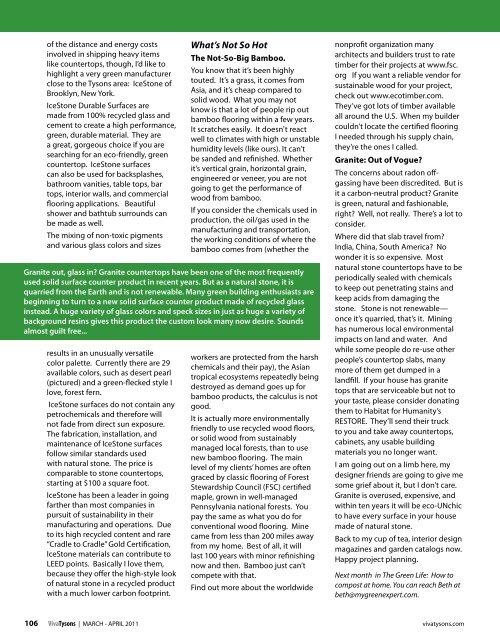March-April - Viva Tysons Magazine
March-April - Viva Tysons Magazine
March-April - Viva Tysons Magazine
Create successful ePaper yourself
Turn your PDF publications into a flip-book with our unique Google optimized e-Paper software.
of the distance and energy costs<br />
involved in shipping heavy items<br />
like countertops, though, I’d like to<br />
highlight a very green manufacturer<br />
close to the <strong>Tysons</strong> area: IceStone of<br />
Brooklyn, New York.<br />
IceStone Durable Surfaces are<br />
made from 100% recycled glass and<br />
cement to create a high performance,<br />
green, durable material. They are<br />
a great, gorgeous choice if you are<br />
searching for an eco-friendly, green<br />
countertop. IceStone surfaces<br />
can also be used for backsplashes,<br />
bathroom vanities, table tops, bar<br />
tops, interior walls, and commercial<br />
flooring applications. Beautiful<br />
shower and bathtub surrounds can<br />
be made as well.<br />
The mixing of non-toxic pigments<br />
and various glass colors and sizes<br />
results in an unusually versatile<br />
color palette. Currently there are 29<br />
available colors, such as desert pearl<br />
(pictured) and a green-flecked style I<br />
love, forest fern.<br />
IceStone surfaces do not contain any<br />
petrochemicals and therefore will<br />
not fade from direct sun exposure.<br />
The fabrication, installation, and<br />
maintenance of IceStone surfaces<br />
follow similar standards used<br />
with natural stone. The price is<br />
comparable to stone countertops,<br />
starting at $100 a square foot.<br />
IceStone has been a leader in going<br />
farther than most companies in<br />
pursuit of sustainability in their<br />
manufacturing and operations. Due<br />
to its high recycled content and rare<br />
“Cradle to Cradle” Gold Certification,<br />
IceStone materials can contribute to<br />
LEED points. Basically I love them,<br />
because they offer the high-style look<br />
of natural stone in a recycled product<br />
with a much lower carbon footprint.<br />
What’s Not So Hot<br />
The Not-So-Big Bamboo.<br />
You know that it’s been highly<br />
touted. It’s a grass, it comes from<br />
Asia, and it’s cheap compared to<br />
solid wood. What you may not<br />
know is that a lot of people rip out<br />
bamboo flooring within a few years.<br />
It scratches easily. It doesn't react<br />
well to climates with high or unstable<br />
humidity levels (like ours). It can’t<br />
be sanded and refinished. Whether<br />
it’s vertical grain, horizontal grain,<br />
engineered or veneer, you are not<br />
going to get the performance of<br />
wood from bamboo.<br />
If you consider the chemicals used in<br />
production, the oil/gas used in the<br />
manufacturing and transportation,<br />
the working conditions of where the<br />
bamboo comes from (whether the<br />
Granite out, glass in? Granite countertops have been one of the most frequently<br />
used solid surface counter product in recent years. But as a natural stone, it is<br />
quarried from the Earth and is not renewable. Many green building enthusiasts are<br />
beginning to turn to a new solid surface counter product made of recycled glass<br />
instead. A huge variety of glass colors and speck sizes in just as huge a variety of<br />
background resins gives this product the custom look many now desire. Sounds<br />
almost guilt free...<br />
106<br />
workers are protected from the harsh<br />
chemicals and their pay), the Asian<br />
tropical ecosystems repeatedly being<br />
destroyed as demand goes up for<br />
bamboo products, the calculus is not<br />
good.<br />
It is actually more environmentally<br />
friendly to use recycled wood floors,<br />
or solid wood from sustainably<br />
managed local forests, than to use<br />
new bamboo flooring. The main<br />
level of my clients’ homes are often<br />
graced by classic flooring of Forest<br />
Stewardship Council (FSC) certified<br />
maple, grown in well-managed<br />
Pennsylvania national forests. You<br />
pay the same as what you do for<br />
conventional wood flooring. Mine<br />
came from less than 200 miles away<br />
from my home. Best of all, it will<br />
last 100 years with minor refinishing<br />
now and then. Bamboo just can’t<br />
compete with that.<br />
Find out more about the worldwide<br />
nonprofit organization many<br />
architects and builders trust to rate<br />
timber for their projects at www.fsc.<br />
org If you want a reliable vendor for<br />
sustainable wood for your project,<br />
check out www.ecotimber.com.<br />
They’ve got lots of timber available<br />
all around the U.S. When my builder<br />
couldn’t locate the certified flooring<br />
I needed through his supply chain,<br />
they’re the ones I called.<br />
Granite: Out of Vogue?<br />
The concerns about radon offgassing<br />
have been discredited. But is<br />
it a carbon-neutral product? Granite<br />
is green, natural and fashionable,<br />
right? Well, not really. There’s a lot to<br />
consider.<br />
Where did that slab travel from?<br />
India, China, South America? No<br />
wonder it is so expensive. Most<br />
natural stone countertops have to be<br />
periodically sealed with chemicals<br />
to keep out penetrating stains and<br />
keep acids from damaging the<br />
stone. Stone is not renewable—<br />
once it’s quarried, that’s it. Mining<br />
has numerous local environmental<br />
impacts on land and water. And<br />
while some people do re-use other<br />
people’s countertop slabs, many<br />
more of them get dumped in a<br />
landfill. If your house has granite<br />
tops that are serviceable but not to<br />
your taste, please consider donating<br />
them to Habitat for Humanity’s<br />
RESTORE. They’ll send their truck<br />
to you and take away countertops,<br />
cabinets, any usable building<br />
materials you no longer want.<br />
I am going out on a limb here, my<br />
designer friends are going to give me<br />
some grief about it, but I don’t care.<br />
Granite is overused, expensive, and<br />
within ten years it will be eco-UNchic<br />
to have every surface in your house<br />
made of natural stone.<br />
Back to my cup of tea, interior design<br />
magazines and garden catalogs now.<br />
Happy project planning.<br />
Next month in The Green Life: How to<br />
compost at home. You can reach Beth at<br />
beth@mygreenexpert.com.<br />
<strong>Viva</strong><strong>Tysons</strong> | MARCH - APRIL 2011 vivatysons.com




